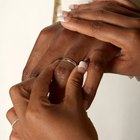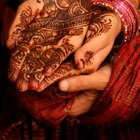
Medioimages/Photodisc/Photodisc/Getty Images
Sometimes spanning as many as four days, a Hindu wedding is both a festival and a deeply symbolic ceremony. The bride and groom are expected to wear certain items of clothing at different stages of the ceremony, along with a range of jewelry, accessories and makeup. Guests are generally encouraged to dress traditionally to a Hindu wedding, but may wear western attire if the hosts are open to it.
The Bride's Two Saris
Traditionally, the bride wears two different saris during the course of a wedding. The first, known as the panetar sari, comes from her birth family, while the second, or gharcholu sari, is provided by the groom's family. The bride wears the panetar sari during the initial wedding rite; after the rite is concluded, she changes into the gharcholu sari for the wedding ceremony itself. To demonstrate that she will be cared for monetarily and physically by her new family, the gharcholu sari should be more expensive than the panetar sari. Because the panetar sari should be made of silk and the gharcholu sari made of cotton, a gold trim is usually added to the gharcholu sari to make sure that it is more expensive than the panetar sari.
Groom
For a traditional Hindu wedding, a groom's attire is divided into two principal areas: what he wears on his head and what he wears on his body. On his head, he can wear a pagri or sehra. The pagri is a turban, while the sehra is a crown with tendrils that frame the face. Usually, he wears the pagri or sehra during the wedding ceremony itself, but not necessarily during any of the other festivities. On his body, the groom may wear a sherwani, a jacket with a round collar, in combination with a long silk shirt known as a kurta and paijama, which are loose-fitting pants.
Other Participants
Bridesmaids at Hindu weddings traditionally wear saris that complement the bride's attire. The bridesmaid saris should not be more valuable or attention-grabbing than the bride's sari. Generally, red is considered a lucky color for Hindu weddings, while white should be avoided, as it is usually a color associated with mourning. Groomsmen may wear suits, or a combination of a sherwani with a salwar or paijama. Usually, the men coordinate their outfits with the groom, much as the bridesmaids coordinate theirs with the bride.
Attendees
Guests attending a Hindu wedding are encouraged to dress in Hindu attire, but they should avoid the color black. Women may wear saris, while men may wear a sherwani with a salwar or paijama. Depending on how traditional the wedding is, guests may choose to avoid Western clothing altogether, although in most contemporary weddings, guests are allowed to wear western suits and dresses.
Related Articles

Traditional Iraqi Wedding Gifts

What Do Chinese Women Wear?

What Is the Traditional Dress Color for ...

Bride & Groom Dress Etiquette for a ...

Marine Corps Uniform Regulations for a ...

What Is the Proper Attire for a Bat ...

Liberian Fashions, Styles & Wedding ...

Mother of the Bride Dress Etiquette

Ideas for an Indian Wedding Anniversary

Wedding Etiquette for Catholic ...

Traditional African Wedding Attire

Quinceanera Requirements

Gifts for an Indian Engagement

Financial Responsibilities of the ...

What Color Dress Does the Mother of the ...

The Proper Attire for a Girl's First ...

Prayer Shawls at Jewish Weddings

What Is the Difference Between ...

Traditional Chilean Wedding Attire

What Is the Difference Between a ...
References
Writer Bio
Julia Lai is a frequent contributor to Los Angeles-based arts and literature publications. She graduated from University of California, Los Angeles with a bachelor's degree in history and has been writing professionally since 2008.
Photo Credits
Medioimages/Photodisc/Photodisc/Getty Images